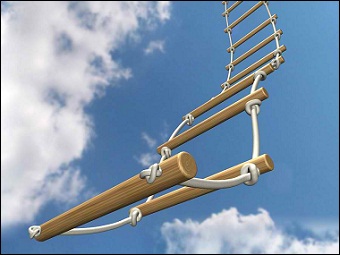 What is a Life Insurance Ladder?
What is a Life Insurance Ladder?
A life insurance ladder is a combination of life insurance policies that create a custom-fit protection solution for a someone with multiple, specific, financial goals.
For instance, Bob may wish to purchase life insurance to:
- Protect his spouse from being responsible to pay off their mortgage upon his death.
- Ensure that his five and six year old children have enough savings set aside to receive a higher education.
- Payoff credit card debt, student loans, and vehicle loans that are all due within ten years, so his wife doesn't have to worry about the debts when he's gone.
Because their family just took out a 30 year mortgage, their children have 20 years left until they're out of college, and their credit cards and other loans won't be paid off for between five and ten years, they have three specific time periods they need coverage for.
The idea behind a life insurance ladder, for example, is that instead of buying one 30 year term policy, for instance, Bob may choose to buy three separate term life insurance policies; a 10 year, 20 year, and 30 year policy. This way he isn't paying for protection against risks whose time have already passed.
When Does It Make Sense To Setup a Life Insurance Ladder?
Each life insurance policy has an annual policy administration fee. A life insurance ladder solution typically only makes sense if the face amounts, or death benefits, for each policy are substantial enough to warrant paying three policy fees.
For instance, if Bob's has a 30 year mortgage in the amount of $500,000, his vehicles, debt, and student loans add up to $300,000, and they want their kids to go to an out of state, higher end college with a combined total tuition of $400,000, a life insurance ladder is going to make a lot of sense.
Why? Because Bob will be able to purchase three separate policies, two of which only have to last for 10 and 20 years. This will save him money in the long, and the appropriate death benefits will be disgarded after the need for them has passed. Because the combined death benefits are relatively substantial amounts, the policy fee for the three policies probably won't be significant concern.
When Does It Make Sense to Buy Just One Policy?
The price difference between using a one-policy strategy vs. a multi-policy strategy in the example above might only be 10% (more expensive for the single policy, because the total death benefit lasts the full 30 years.). If the face amounts are in the $100,000 to $400,000 range, it may be worth the bit of extra money to have the higher death benefit for the longer term. In other words, saving a few bucks to have a life insurance ladder won't be worth the benefits that drop off at the 10 and 20 year marks.
While life insurance ladders are an effective solution in many cases, they aren't in others. Before creating a custom life insurance ladder solution, sit down with a financial advisor and discuss the amount of insurance you need, the time frame you need it for, and your specific goals for buying a policy. A life insurance advisor can put the two options side-by-side for you, and help you determine which solution is most effective in terms of protection and cost.
Handling Temporary Cost Spikes When Expanding Your Insurance Ladder
Marriage, a new mortgage, or the birth of a child can increase your required coverage before older policies roll off. If a short‑term cash crunch makes the first higher premium hard to swallow, consider a regulated micro‑advance like $255 payday loans online same day. The quick deposit keeps your ladder intact until your budget adjusts to the life change.
Keep Coverage Active Without Hurting Your Credit Score
Underwriting for a new ladder rung can take weeks, and missing a payment on an existing policy risks lapse. An income‑based option such as payday loans no credit check provides bridge cash with no hard inquiry, safeguarding both your life insurance continuity and your credit profile.
Lock In Long‑Term Protection and Spread the Up‑Front Cost
Securing a $250 k–$500 k policy to cover retirement‑age obligations may require a sizable first premium. A focused installment solution like a $2,000 loan no credit check direct lender lets you pay that initial bill now and retire the balance over six to twelve months, completing your ladder strategy without draining emergency savings.







Leave a Reply: